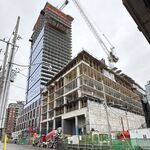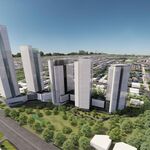Acording to my estimates, such operation is not even physically possible. I'll use meters and seconds (that's easier), and then convert to kph at the end.
Max. comfortable acceleration / deceleration rate: 2 m/s^2 (20% of "g"). Speed profile and timing for a 500 m stop spacing:
a) First 100 m: accelerating from 0 to 20 m/s, takes 10 sec
b) Next 300 m: constant speed 20 m/s, takes 15 sec
c) Last 100 m: decelerating from 20 to 0 m/s, takes 10 sec
I chose 20 m/s (72 kph) as top speed, that value makes the calculations very easy; but we can take a somewhat different value and arrive to a similar result.
Total travel time between stops: 10 + 15 + 10 = 35 s
Time at stop: 30 s
Combined travel time and time at stop: 65 s
Average speed: 500 m / 65 s = 7.7 m/s, or 7.7 x 3.6 = 27.7 kph
The above calculation does not take into account any delays such as waiting at the red lights (even if Transit Signal Priority is in place, it can't guarantee 100% green on demand). Thus, the speed would be even a bit lower in practice; closer to 26 kph.
Looking from another angle, it is hard to imagine how a street-median line with 500 m stop spacing can be as fast as the fully separated BD line with 700 m stop spacing.




